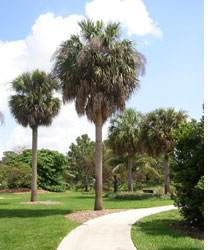Plants suited to your site will require minimal amounts of water, fertilizer and pesticides.
1. Use plants suited for site conditions:

Low lying areas, select moisture loving plants
Shady areas, select plants with low light requirements
Sunny, dry locations, select drought tolerant plants.
2. Group plants according to their water needs.
3. Plant drought tolerant plants together and avoid scattering throughout lawn areas.
4. Determine how much grass you need for children, pets and recreation,. Use low maintenance ground covers, shrubs and mulch or other porous substances where possible.
5. Plant trees and shrubs to shade air conditioners and the east or west walls of your house to conserve energy. It will save you money!
6. Use deciduous trees or shrubs on the
 south side of your house to passively heat your home in the winter.
south side of your house to passively heat your home in the winter.
7. Remove invasive exotic plants from your yard! This will help to keep the dastardly Melaleuca,
Australian Pine,
Brazilian Pepper,
Air Potato, Old World Climbing Fern,
Carrotwood,
Earleaf Acacia and
Schefflera from seeding and spreading into other areas.
8. Reduce pruning labor and time by selecting plants with desired heights at maturity for particular locations. A plant that reaches a height of 8-10 feet will not be happy in place suited for a 2 foot plant. This will also cut down on yard waste.
9. Preserve and plant native plants whenever possible. They really like our hot humid summers!
 OTHER LANGUAGES
OTHER LANGUAGES
 OTHER LANGUAGES
OTHER LANGUAGES